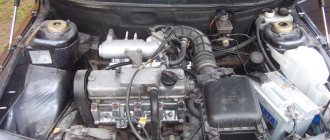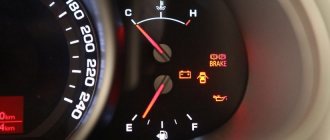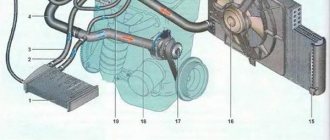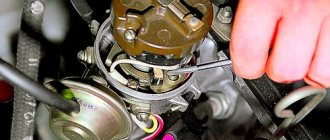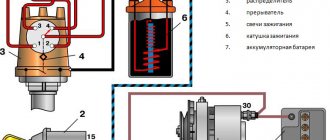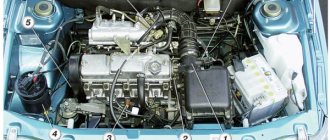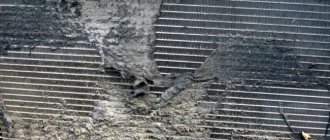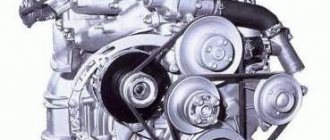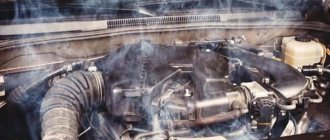The engine of the domestic classic VAZ 2106 has a volume of 1.6 liters and can be either carburetor or injection. The engine is four-cylinder with an overhead camshaft. The resource of the power unit is 125,000 km, but, as a rule, it can withstand longer mileage, although it has not gained a reputation as the most reliable among car enthusiasts.
One of the common problems with this motor is severe overheating under certain conditions. The VAZ 2106 engine heats up when there is a malfunction of the systems associated with it, for example, the radiator and thermostat. Below we will discuss all the reasons why the engine overheats.
The experience of drivers has shown that the carburetor engine of the VAZ “Six” is not as often susceptible to various malfunctions than the injection engine. In the hot season, a worn-out engine overheats quite easily, even if the antifreeze level is normal. The engine operating temperature should not exceed 96°.
What is the operating temperature of the VAZ 2106 engine
One of the common problems with this motor is severe overheating under certain conditions. The VAZ 2106 engine heats up when there is a malfunction of the systems associated with it, for example, the radiator and thermostat. Below we will discuss all the reasons why the engine overheats.
The experience of drivers has shown that the carburetor engine of the VAZ “Six” is not as often susceptible to various malfunctions than the injection engine. In the hot season, a worn-out engine overheats quite easily, even if the antifreeze level is normal. The engine operating temperature should not exceed 96°.
Radiator clogged: nuances
The radiator can become clogged with various small debris, everyone knows this. Only regular cleaning can save you from this, especially in the warm season, when there is a lot of dust, insects, and poplar fluff in the air. If the antifreeze is of low quality or you forgot to change it on time, then the blockage is aggravated from the inside.
So, you need to clean the radiator. We wait until the engine cools down. Drain the antifreeze. Already by the drain you can determine how damaged the radiator is from clogging. The antifreeze itself may also be the reason why the VAZ is heating up, and this will be clear from its color. To clean the radiator and its channels from the inside, it is best to fill with water and warm up the engine until the operating temperature of the engine is reached. Then turn off, wait until the engine cools down, and drain the water. Repeat if necessary. If this does not help, then it is better to contact a car service center or replace the radiator with a new one. Flushing the radiator yourself should be approached with caution.
Overheating of the VAZ 2106 engine can occur when a fan breaks down, a leak in the pump and a subsequent decrease in pressure in the cooling system, when using fuel with a higher octane number than required.
Cleaning the radiator using an automatic manual car wash
The engine gets very hot
It is worth noting that a carburetor engine encounters this problem much less often than an injection engine. Even on hot summer days it holds the temperature well and does not exceed 96 degrees. Why does the engine get hot?
- The thermostat malfunctions. As they say, the valve “caught the wedge.” This can be checked very simply: you need to touch the bottom of the thermostat with your hand. If it is cold, then the problem is in the thermostat valve. Another sign of a non-working thermostat: the radiator outlet is very overheated. As a result, this valve is kept closed, the liquid does not enter the radiator and boils. If in this state it penetrates into the piston part, as well as into the oil sump, this can lead to critical engine failure. Therefore, if a malfunction is detected, you need to turn off the engine and replace the thermostat with a working one.
The appearance of an air lock in the radiator pipes. To eliminate this problem you will have to bleed the entire system. The radiator is clogged. To avoid this problem, you need to clean the radiator regularly, especially during the hot summer season.
You also need to use only high-quality coolant to avoid clogging the radiator from the inside. You can also pay attention to whether the fan is broken. Another common reason that the VAZ 2106 engine may overheat is a breakdown of the water pump. The pump often leaks
You can check the operation of this part as follows: at engine operating temperature, sharply squeeze the inlet pipe on the radiator. In this case, the working pump produces a noticeable pulsation. It also doesn’t hurt to check the pump seal, which starts to leak from time to time.
Water Pump Review
If the pump breaks, overheating of the engine cannot be avoided, because pumping coolant depends on it. The pump can be checked for functionality in several ways. Usually it is enough to simply bring the engine to operating temperature and sharply tighten the upper radiator hose. If pulsation is felt, it means the pump is working. But there is another weak spot - the pump seal, which also sometimes leaks. The malfunction is noticeable only upon careful inspection. If you find a leak, replace the oil seal.
Overheating can also occur when the pump shaft bearings wear out. The presence of play at the pump shaft means that the bearings do not have much time left and the part needs to be replaced.
In some situations, the water pump needs to be carefully inspected to find out what happened. One of the reasons for poor pump performance may be play in the drive pulley. If the pump bearings begin to crumble, a characteristic sound will be heard from the operating pump.
Remove the pump and examine the drain hole at the bottom. If there are droplets of liquid at the drainage end, the pump has leaked and the seal needs to be replaced. It is dangerous to plug the hole; the pump will quickly and completely break, which can lead to even worse consequences for the engine.
For preventative purposes, periodically open the hood and listen to the engine at idle speed.
This will help avoid both troubles with the pump and a number of other breakdowns. Take care of your car, then it will serve you for a long time.
Device
The first place where the fluid begins its flow is the radiator. On VAZ 2106 models, two types of radiators were installed - copper and aluminum. The first one is of higher quality, and if cracks appear on its surface, they can easily be welded. In contrast, any crack on an aluminum part is its certain death.
The radiator figuratively consists of three parts: the upper barrel, the cooling honeycomb and the lower barrel. The upper tank has a filler neck for adding coolant. During operation, hot liquid that has gone through one cycle is collected in this tank. Further, it descends into the lower barrel, through the honeycombs, simultaneously being cooled by a fan. And in the lower tank, the liquid is already completely cooled and ready for use.
Radiator design
Tubes are connected to the radiator from above and below: two wide and one narrow. A narrow tube connects the radiator to an expansion barrel, designed to allow excess liquid to enter it during heating and expansion. The upper wide tube connects the part to the thermostat, which, in turn, uses a valve to regulate the flow of coolant. Fluid can flow from the thermostat either back to the engine cylinder block or to the radiator.
For forced circulation, the system includes a pump that pumps antifreeze, creating pressure inside the block. Between the cylinders, a specially made void is provided, where this liquid enters.
Thermostat and cooling system operation
The cooling system thermostat accelerates engine warm-up and maintains the required thermal operating conditions of the engine. At optimal thermal conditions, the coolant temperature should be 85-95°C.
Thermostat 38 consists of a body 43 and a cover 46, which are rolled together with the seat of the main valve 41. The thermostat has an inlet pipe 40 for inlet of cooled liquid from the radiator, a pipe 44 of a bypass hose 5 for bypassing liquid from the cylinder head to the thermostat, and a pipe 45 for supplying coolant fluid into pump 36.
The main valve is installed in a thermoelement glass, in which a rubber insert 39 is rolled. The rubber insert contains a polished steel piston 47, mounted on a stationary holder. A heat-sensitive solid filler is placed between the walls and the rubber insert. The main valve 41 is pressed against the seat by a spring. Two posts are attached to the valve, on which a bypass valve 42 is installed, pressed by a spring.
Engine cooling system VAZ 2106, 2103, 2101: 1 – coolant supply hose to the heater radiator; 2 – hose for draining coolant from the heater radiator; 3 – heater tap; 4 – heater radiator; 5 – liquid drain tube; 6 – coolant drain hose from the inlet pipe; 7 – expansion tank; 8 – radiator supply hose; 9 – radiator cap; 10- upper radiator tank; 11 – radiator tube; 12 – electric fan; 13 – lower radiator tank; 14 – radiator outlet hose; 15 – coolant pump; 16 – hose for supplying coolant to the pump; 17- thermostat; 18 – thermostat bypass hose.
The position of the thermostat valves at different coolant temperatures: / – from the cylinder head; II – to the coolant pump; III – from the lower radiator pipe; 1 – main valve, 2 – bypass valve.
The engine cooling system 2106, 2103, 2101 is liquid, closed type with forced circulation. On a cold engine, the fluid circulates in a “small circle”. It includes the cooling jackets of the engine block and cylinder heads, the coolant pump, the thermostat, and the heater core when its valve is open. When the liquid temperature reaches 80-85°, two thermostat valves come into action, closing the small circle and opening the liquid path through the engine radiator, which is intensively blown by the oncoming flow of air when driving, as well as with the help of an electric fan.
The radiator consists of two horizontal tanks connected to each other by tubes. For better heat dissipation, plates are pressed onto them. The liquid is supplied to the radiator through the upper pipe and discharged through the lower one.
Passing through the radiator, the liquid cools and then flows back into the engine. The expansion tank compensates for changes in the volume of coolant when it is heated or cooled. For visual monitoring of the coolant level, the tank is made of translucent polyethylene.
The tightness of the system is ensured by the inlet and outlet valves of the radiator filler plug. When the engine is hot, the exhaust valve maintains increased pressure in the system. Due to this, the boiling point of the liquid increases. When it cools, the inlet valve opens, allowing some of the liquid from the expansion tank to enter the radiator and thereby compensating for the decrease in liquid volume.
There is a hole in the expansion tank plug, so the pressure in its internal cavity is always atmospheric.
Centrifugal type coolant pump. The pump housing is aluminum, dismountable, and consists of two parts. The pump shaft rotates in a closed double-row bearing that does not require maintenance. The pump drive pulley flange is pressed onto the front end of the shaft using a V-belt from the engine crankshaft pulley.
Recently, cars have been equipped with radiators with plastic tanks and an aluminum core.
It is not recommended to fill the engine cooling system with water. This leads to the formation of scale on the walls of the system, corrosion of parts, deterioration of heat transfer and a reduction in the service life of the pump seal.
Late ignition, signs, causes
The engine doesn't start well
Several attempts are required before the car engine starts.
Unstable engine idling
You can equalize the speed only by adding excess fuel mixture with the screws on the carburetor. In this case, the idle speed will be higher than normal.
Reduced power and throttle response
The car engine does not turn on. There is sluggish car dynamics when accelerating and driving at low speeds. In this case, the engine may stall when you press the gas. When driving at high speeds, the loss of power may not be noticeable.
Spark plugs white or light gray
In some cases (if there are some associated problems), when ignition is late, there may be a black dry coating on the electrodes of the spark plugs.
Shooting the carburetor
The fuel burns out in the intake manifold. It does not have time to burn completely and is thrown out into the intake manifold during the exhaust stroke with characteristic pops.
The engine constantly overheats
Since the fuel mixture burns out during the expansion stroke (power stroke), this causes some overheating of the engine.
Causes of late ignition
The ignition timing is incorrectly set
The main reason for too late ignition is an incorrectly set ignition timing. A certain amount of fuel requires its own advance angle. See more details.
The vacuum ignition timing regulator is faulty
When accelerating the car, when the throttle valves open, the vacuum regulator should set the early ignition timing. If it breaks and the angle remains later, the engine stops pulling and stalls.
The centrifugal ignition timing regulator is faulty
If the initial ignition timing is set correctly, but there are still signs of too late ignition, then the centrifugal ignition timing regulator should be checked. It should start working at a speed slightly above idle speed and gradually, depending on the engine speed, increase the angle. Broken or jammed governor springs can cause the centrifugal governor to not advance the ignition timing when the engine is running under load and the ignition will be too late.
The gap between the breaker contacts is too small
On VAZ 2105, 2107 cars with a contact ignition system, you should check the gap between the contacts of the breaker in the distributor, since its value directly affects the ignition timing.
The phases in the timing drive are out of order
For example, after replacing the timing belt or chain, the relative position of the crankshaft and camshaft was not aligned accurately (the alignment marks do not match).
Notes and additions
— The main check for the presence of early or, conversely, late ignition on VAZ 2105, 2107, 2108, 2109, 21099 cars is a check in motion. When, moving at a speed of 40-50 km/h, on a flat section of the road, we sharply press the gas pedal. There should be a small short-term detonation (fractional, chirping sound from the engine compartment). If it appears and disappears, good, the ignition is set correctly. It appears and does not go away, the ignition is too early. There is no detonation - late ignition.
Source
Airlock
Draining the air lock from the cooling system through the radiator drain manifold
Another reason why the engine gets hot is the presence of air in the car radiator pipes.
The problem occurs due to differences in the density of antifreeze and air and makes it difficult for coolant to move through the system. In this case, the cooling system must be pumped. How to do it?
There are several ways to pump and remove traffic jams. You can drive up to an elevation (hill) and rev it up for a while
Sometimes, when filling in coolant, it is enough to jack up the car on the right side, or you can just drive for half an hour, the air will come out on its own, only in this case the level of antifreeze will drop significantly, so the latter method requires caution. You can also pump the radiator pipes with your hands one at a time using rhythmic pressure.
If you remove the cap from the coolant expansion tank, you will immediately see from which hose the air is coming out (through the bubbles).
Correct driver actions
In situations where the engine overheats but the radiator remains cold, it is important to take the right measures to prevent the situation from getting worse and also try to prevent any serious malfunctions and costly breakdowns. Sometimes it happens that the driver panics ahead of time
This usually happens to motorists who have only recently gotten behind the wheel, or who have changed cars without having yet had time to get used to the peculiarities of its behavior and the operating modes of the engine itself.
Sometimes it happens that the driver panics ahead of time. This usually happens to motorists who have only recently gotten behind the wheel, or who have changed cars without having yet had time to get used to the peculiarities of its behavior and the operating modes of the engine itself.
Here we are talking about short-term overheating, which can to a certain extent be considered the norm for many engines. Short-term overheating usually occurs when sitting in a traffic jam for a long time. Then the temperature sensor arrow displayed on the dashboard rises to the critical red zone. But as soon as the car starts moving, when airflow appears due to oncoming air flows, and the cooling fan is activated, the temperature returns to normal. That is, first, try to observe and see whether the temperature will drop after a jump upward, to the red zone.
But you shouldn’t wait and watch when the car was in motion, that is, there was oncoming air blowing, or the fan was running. In such situations, experts give several useful recommendations:
- If the car was moving under completely normal conditions that do not provoke short-term overheating, but the temperature still begins to increase and reaches a critical level, do not immediately turn off the engine;
- Also, do not try to cool the power unit by pouring cold water on it from the outside, or by adding cold water to the expansion tank with cooling liquid;
- If you ignore these recommendations, fill the engine with water or add it to the tank, you will probably have to repair the engine. Moreover, such repairs are often accompanied by a mandatory replacement of the cylinder block and cylinder head;
- If you want to cool the engine, lower the engine temperature with a cold radiator to normal levels, it is better to drive off the road, stop and turn on the heater in the car. It doesn’t matter if it’s spring or summer, the cabin is warm enough without the heating working;
- Turning on the heater will remove excess heat from the engine, transferring it to the interior of your car;
- At the same time, you cannot turn off the engine itself. Just move the gearbox to neutral and leave the engine idling;
- Wait a few minutes after completing all the steps described;
- At the same time, check for any signs of coolant leakage. To do this, you will have to get out of the car, look under the car and into the engine compartment;
- If there are no leaks, then the manipulations carried out with the stove and the idle speed of the power unit did not allow the temperature to drop below the critical level, turn off the engine.
Install hydraulic compensators
As for me, the engineers who designed and assembled this car apparently simply forgot to install them at the factory. There are very few hydraulic compensators there. But you can deliver them yourself.
Installing “hydriki”, which come from Niva, will help you get out of this situation. The main thing is to choose a suitable ramp and fill only high-quality oil, then there will be no problems, and you will forget what adjustment is.
So, the “kopek” and the Niva with the VAZ-21214 engine have identical heads with identical seats for the adjusting bolts. Consequently, their timing parts are interchangeable. For modification, hydraulic compensators 21214-1007160, camshaft 21214-1006008-00 and hydraulic compensator oil supply ramp assembly 21214-1007180SB are needed.
Let's look at the most likely causes of engine overheating
1. The reasons may be different. The most common is a lack of coolant. The reason for overheating of the VAZ 2106 engine may be too little antifreeze in the car’s cooling system. Coolant can be lost due to unnoticeable cracks and small holes in various places.
For those who understand something about the structure of a car, it will not be difficult to detect this problem. If you do not use the vehicle for some time, you may notice spilled antifreeze on the asphalt. You will need to check the car's radiator or hose. The only solution is to replace the damaged parts.
If no coolant leakage is detected, then the cause may be in the engine. If antifreeze flows into the inside of the engine, then a very complex repair is needed and cannot be done without professionals. This may cause water hammer. Therefore, you need to immediately contact the service station.
2. The reason may be in the VAZ 2106 radiator fan. Check the belt tension level. If the fan has a temperature sensor, then it may be faulty. It is necessary to monitor the condition of the radiator, as this also affects engine overheating. If, after careful care, the engine continues to boil, you should buy a new radiator.
3. A broken thermostat may be one of the reasons for engine overheating. Its internal parts may lose their characteristics over time. And driving on congested streets, standing in traffic jams and at traffic lights - lead to the engine getting very hot due to poor airflow. Only at high speeds does the cooling system work perfectly.
4. On older VAZ 2106 cars, the ignition may be set incorrectly, which leads to overheating. But this is rare, because all modern cars are equipped with electronics and everything is controlled by a computer.
5. The last cause of overheating may be a burst engine exhaust valve. Hot gases enter the motor, and it heats up to a high temperature, as indicated by the arrow on the sensor.
Source
The thermostat is broken
A thermostat is a special component in a car that regulates the temperature in the cooling system. It closes and opens the valve that directs the flow through the so-called “small” or “large” (through the radiator) cooling circle. The thermostat is an important part, and if it malfunctions, it will cause serious overheating of the engine.
In the old days, drivers, owners of Soviet cars in the southern regions of the country, simply pulled out the thermostat for summer time and operated the car without it. You can check the operation of the thermostat by touch by touching the upper pipe leading to the cooling radiator. If the engine is cold when the engine is running, it means the fluid is not reaching the radiator. Thermostats are tested using a container of boiling water. The device in it should work - open slightly for a few seconds. If this does not happen, the part is faulty and must be replaced.
Why does the VAZ 2106 heat up in the summer? All about engine overheating
Usually the VAZ 2106 heats up in the summer heat, but this can happen in the spring and autumn, and even in the frosty winter! In addition, in this situation there is a threat of failure of important components of the vehicle. A possible cause may be wear on the oil seals or rings on the piston. They, as a rule, lie down and stop performing their direct duties.
From high temperatures they become unusable, and increased combustion of oil begins. Also, when the engine overheats, the cylinder block becomes deformed. This is already a serious problem, since urgent repairs will require a considerable amount of money, which will certainly affect the family budget. It is not difficult to determine if a car engine is overheating. There is a sensor on the instrument panel for this purpose. The arrow will show a temperature of more than 100 degrees.
The sound of boiling liquid may be heard from under the hood of the car. Sometimes there is even steam. In this case, you urgently need to stop the vehicle and turn off the engine. Slowly open the hood, followed by a barrel of antifreeze so that the hot steam comes out. It is better to immediately turn on the fan to cool the overheated radiator.
Engine overheating at idle speed
It is worth noting that not only the thermostat can cause engine overheating. This can simply be caused by an insufficient amount of coolant. Therefore, you should not immediately change this part; it is better to first check its functionality. After all, you can find out about its working condition without taking it out of the hood. If the thermostat is not functioning, the top hose on the engine will either be cold or very hot. In this case, it must be replaced.
There is another way to check the thermostat. To do this, you need to remove it and place it in a pan of water. Next, bring to a boil and see if the thermostat opens for a few seconds, then it is in working order, if not, then it should be replaced.
During idling, the engine may become hot due to faulty spark plugs and the ignition system. With this problem, a drop in speed may be felt during acceleration. Faulty spark plugs can lead not only to poor dynamics, but also to an increase in the temperature in the engine by over 1000C. All this occurs due to the fact that the ignition system makes poor contact and, as a result, one of the cylinders begins to function less.
It happens that the spark plug has already served its time and needs to be replaced. This fact can be detected if you look at its end; it is covered with black soot
If after replacement the problem is not solved, then you need to pay attention to the cover of the breaker-distributor. If there are cracks on it, then it has become unusable
Well, if everything is in order, then you can replace the wires, sliders or distributor cover.
The engine may also overheat due to a coolant leak. This problem is very easy to spot. When the temperature arrow approaches the maximum mark, you need to turn on the stove. If there is no or insufficient antifreeze, cold air will blow from the oven. This problem is the most common among most car enthusiasts. It is not recommended to continue driving without coolant. Also, if a leak occurs, a stain will appear under the hood when stopped for a long time.
Another common problem is the pipes not being sealed. If possible, they should be replaced, but if a breakdown occurs on the road, you can wrap it with electrical tape and take your time to the auto shop. The main thing is to monitor the level of antifreeze in the tank.
Let's sum it up
If the temperature indicator needle exceeds the maximum level, then you should turn the stove on to maximum and stop. If nothing changes within 1-2 minutes, the engine is turned off and the hood opens. You should wait until the engine cools down. Do not pour cold water on the motor. Otherwise, microcracks may form on the block head, which will lead to serious repairs.
After the engine has cooled, you need to disconnect the radiator valve. This should be done with gloves and long sleeves, otherwise hot pores can lead to burns. When all the pores have evaporated, you need to fill the coolant to the required level.
After this, the fan is forced to turn on. Further movement is only possible at low speed and with the heater on. This will allow the oncoming flow to properly blow on the radiator and reduce the load on the engine.
If you suddenly need to remove the cap located on the expansion tank, it is not recommended to do this when the engine is boiling. After all, antifreeze tends to expand during operation and if you unscrew the cap, it will fly out with tremendous force, like a champagne cork. And if you touch the lid without gloves, you can get a severe burn. Therefore, if you need to remove the lid, you must wait until the liquid has completely cooled. And do not forget that then the lid only needs to be screwed on halfway.
To prevent the engine from boiling, you should periodically look at the temperature gauge needle. This will allow you to stop in time and fix a small problem, rather than lead your car to costly internal combustion engine repairs.
Liquid pump
This element of the system allows you to improve the circulation of fluid through the pipes and radiators. Of course, due to the fact that hot antifreeze moves, displacing cold, the system will work somehow
However, it is extremely important to give additional acceleration to ensure two conditions. Firstly, the liquid should not be heated to critical temperatures
Secondly, it must cool as quickly as possible. Short-term heating and cooling allow you to maintain the temperature at a given level.
The liquid pump is a rotor in an aluminum casing, which has an impeller on the inside and a drive pulley on the outside. It is with the help of the impeller that the cooling system of the VAZ-2106 works normally (the flow diagram of the fluid flow is shown in the figure above). The impeller is made of plastic. But there are also aluminum samples, but it is unwise to use them for the reason that they can quickly collapse if water is used rather than antifreeze. The most common pump failure is a bearing failure. It can break gradually if the drive belt is over-tensioned.
https://www.youtube.com/watch?v=https://www.youtube.com/watch?v=tVZI0WCXRXk
Small circle of fluid circulation
Let's say you start a cold engine. The process of fluid circulation in it begins instantly, from the first revolutions of the crankshaft. The liquid begins its movement first in a small circle. It includes all elements except the radiator. The cooling system of the VAZ-2106 engine functions in such a way that when the liquid circulates in a small circle, the heater radiator warms up. In addition, due to the rapid movement of the liquid, which does not have time to cool, less time is spent warming up the engine.
Let's look at the most likely causes of engine overheating
1. The reasons may be different. The most common is a lack of coolant. The reason for overheating of the VAZ 2106 engine may be too little antifreeze in the car’s cooling system. Coolant can be lost due to unnoticeable cracks and small holes in various places.
For those who understand something about the structure of a car, it will not be difficult to detect this problem. If you do not use the vehicle for some time, you may notice spilled antifreeze on the asphalt. You will need to check the car's radiator or hose. The only solution is to replace the damaged parts.
If no coolant leakage is detected, then the cause may be in the engine. If antifreeze flows into the inside of the engine, then a very complex repair is needed and cannot be done without professionals. This may cause water hammer. Therefore, you need to immediately contact the service station.
2. The reason may be in the VAZ 2106 radiator fan. Check the belt tension level. If the fan has a temperature sensor, then it may be faulty. It is necessary to monitor the condition of the radiator, as this also affects engine overheating. If, after careful care, the engine continues to boil, you should buy a new radiator.
3. A broken thermostat may be one of the reasons for engine overheating. Its internal parts may lose their characteristics over time. And driving on congested streets, standing in traffic jams and at traffic lights - lead to the engine getting very hot due to poor airflow. Only at high speeds does the cooling system work perfectly.
4. On older VAZ 2106 cars, the ignition may be set incorrectly, which leads to overheating. But this is rare, because all modern cars are equipped with electronics and everything is controlled by a computer.
5. The last cause of overheating may be a burst engine exhaust valve. Hot gases enter the motor, and it heats up to a high temperature, as indicated by the arrow on the sensor.
Every car owner sooner or later encounters an engine malfunction. It cannot be said that VAZ 2106 engines are exceptions to this rule. Some breakdowns occur more often than others. In this article we will look at the most common problems with a six-wheel engine and how to fix them.
- troit engine for VAZ 2106;
- the motor gets very hot;
- a knock is heard in the engine;
- the power unit smokes;
- the engine is breathing;
- works unstably and intermittently.
Where is the engine number
Each vehicle model produced at the factory is equipped with an engine with a personal number. So, the engine number on the “seven” is its identification number, which can be used to determine the identity of the stolen car and its history.
The engine number is stamped on the cylinder block on the left side, immediately below the distributor. In addition, the number is duplicated in the summary table, which is attached below the air supply housing. The metal plate contains information about the car, such as model, body number, model and number of the engine unit, equipment, etc.
The number is stamped on the left side of the cylinder block
The engine does not warm up for a long time
With the arrival of cold weather, many car owners notice that the engine takes a very long time to warm up. Sometimes you need to drive a considerable distance in order for the temperature to at least approach the operating temperature. Why does this happen?
The temperature considered normal (operating) for different engines may differ, but on average this value is 90 degrees. If you have driven, say, ten kilometers in normal mode, and the temperature gauge does not show more than 70, then you can safely say that the engine is not warming up.
A device called a “thermostat” is responsible for the thermal balance of the engine. This is a kind of valve that switches the movement of coolant between two circuits - small and large - depending on its temperature. A large circuit runs through the main radiator, located between the headlights, where the fluid cools the most. The operating thermostat allows coolant to flow into the radiator when it reaches a certain temperature, and until that point, the fluid circulates around the radiator for faster heating.
Sooner or later, the thermostat stops working and, according to the law of meanness, its valve jams in the most “inappropriate position”: in the summer - on a small circle (the engine overheats, read why the engine on a VAZ-2106 gets hot), and in winter - on a large circle (cold fluid constantly goes through the radiator). Due to premature cooling in the radiator, antifreeze or antifreeze cannot heat up to operating temperature, which affects the general operating conditions of the engine.
An engine that is unable to reach operating temperature consumes more fuel and moving parts experience premature wear. The situation also affects the comfort in the cabin - the air coming from the heater is far from hot.
What to do? Ideally, the thermostat needs to be changed. However, if you need the car every day and there is no time for repairs, you can use two methods.
The first is to insulate the radiator. This can be done with ordinary cardboard placed between it and the radiator grille. This classic technique has been used for many decades in severe frosts, but if there are problems with the thermostat, it is not a sin to use it even at low subzero temperatures. By closing the radiator, you will block the air flow to it and reduce the cooling of the liquid - the engine temperature will increase.
The second method is to reduce the temperature of the air from the heater. The interior “stove” is essentially the same radiator, only small (read how to flush the heater radiator) and cools the engine well. By lowering the temperature on the heater control panel, you will raise it at the engine.
When driving with the thermostat not working and the radiator closed, it is important to monitor the engine temperature. The thermostat valve may “wedge” due to vibration and the device will work
Since the main radiator is closed, the engine may not only reach operating temperature, but also overheat.
But if there is severe frost outside, below -25 degrees, then, even with a working thermostat, the engine may not warm up. This is a normal phenomenon and can be corrected with the same cardboard in front of the radiator. This method was used by our great-grandfathers, and it still lives today, not only on Russian cars, but also on foreign cars.
In severe frosts, it is also important to take care of insulating the hood. You can glue its lid on the inside with noise- or heat-insulating materials or use a special insulating cape
If you're going on a long road trip and the forecast is warmer, make sure the cooling fan is running properly to avoid overheating the engine.
And, finally, a trick that can be used to temporarily revive a jammed thermostat. If the design of the car allows, you can quietly but sharply hit the thermostat housing with the handle of a screwdriver or a wrench. Often, from such a blow, the thermostat valve breaks away from its wedge position and begins to work normally. You need to understand that such a measure is temporary and, when the engine is restarted, the valve will most likely jam again. Therefore, you need to replace the thermostat with a working one as soon as possible.
Source
Causes of boiling and their solutions
To begin with, we will analyze in detail all the reasons why antifreeze boils.
- Faulty thermostat .
The main task of this device is not to supply coolant to the radiator until the engine reaches a certain operating temperature (usually +85°C), that is, to transfer it to the so-called “large circle”. However, if the unit does not turn on in time and does not circulate the coolant through the system, it will quickly heat up in the “small circle” along with the engine and simply boil because it will not have time to cool. Dirty thermostat - Faulty radiator . The function of this unit is to cool the antifreeze and maintain the cooling system in working order. However, it may suffer mechanical damage or simply become clogged from the inside or outside.
- (centrifugal pump) failure Since the task of this mechanism is to pump coolant, if it fails, its circulation stops, and the volume of liquid that is in close proximity to the engine begins to heat up very much and, as a result, boils.
- Low antifreeze level . A cooling system that is not filled to the required level does not cope with its task, so the temperature exceeds the critical temperature and the liquid boils.
- Cooling fan failure . Its function is to force cool the elements of the system of the same name and the liquid. It is clear that if the fan does not turn on, the temperature will not drop and this may result in the antifreeze liquid boiling. This situation is especially critical for the warm season.
- Presence of an air lock . The main reason for its appearance is depressurization of the cooling system. As a result, several factors harmful to it arise at once. In particular, the pressure drops, which means the boiling point of antifreeze decreases. Further, when air remains in the system for a long time, the inhibitors included in the antifreeze deteriorate and do not perform their protective function. And finally, the coolant level drops. This has already been mentioned earlier.
- Temperature sensor failure .
Everything is simple here. This unit has not sent the appropriate commands to the thermostat and/or fan. They did not turn on and the cooling system and radiator boiled. Pump corroded by antifreeze - Poor quality antifreeze . If the car is filled with low-quality antifreeze, that is, a liquid that does not meet the necessary requirements, which means there is a high probability that the radiator will boil. In particular, we are talking about the fact that counterfeit coolant often boils at temperatures below +100°C.
- Antifreeze foaming . This can happen for various reasons. For example, low quality coolant, mixing incompatible antifreeze, using antifreeze that is not suitable for the car, damage to the cylinder block gasket, which causes air to enter the cooling system, and as a result, its chemical reaction with the coolant to form foam.
- Depressurization of the tank lid . The problem may be either a failure of the safety bleed valve or a depressurization of the cover gasket. Moreover, this applies to both the expansion tank cap and the radiator cap. Because of this, the pressure in the cooling system is compared to atmospheric pressure, and therefore the boiling point of the antifreeze decreases.
To restore the functionality of the cooling system, and in future to prevent situations where antifreeze or antifreeze boils quickly, it is necessary to inspect the components listed above. Let us list the sequence in which it is necessary to check the specified components in accordance with the probability and frequency with which they fail.
Antifreeze foaming
- Expansion tank and its cap . This is especially true if the antifreeze in the expansion tank has boiled and steam is coming from underneath it. It is better to replace the entire cap and valve.
- Thermostat . This unit needs to be checked if the radiator is cold and the antifreeze is boiling when the engine is turned on. It also makes sense to check the thermostat after replacing the coolant if it immediately boils.
- Cooling Fan . It rarely fails, but it makes sense to check. As a rule, problems arise in dropped contacts or breakdown of the insulation of the stator and/or rotor windings.
- Temperature sensor . The device is quite reliable, but sometimes fails on older machines. Actually, it controls the operation of the fan on the radiator
- Centrifugal pump (pump) . This is similar to the previous point..
- Cooling radiator . It is necessary to carefully inspect it for damage and possible coolant leaks. If it leaks (this will be accompanied by a situation where antifreeze is leaking), then it is necessary to dismantle it and solder it. As a last resort, replace it with a new one. You can simply clean it if it is very clogged. For external cleaning it is better to remove it. And internal cleaning occurs along with the entire cooling system (without dismantling).
- Check the antifreeze level in the system . It can leak from a damaged system, and the remaining volume cannot withstand the heat load and boils. If a low-quality liquid with a low boiling point is used, it must be replaced completely. Otherwise, you can simply add antifreeze.
- Check whether the added antifreeze is suitable for the current car . If there was a mixing of two brands of coolant, make sure that they are compatible with each other.
- Check the operation of the safety release valve . You can check the operation of the valve on the lid using polyethylene.
- Check the quality of the filled antifreeze . This can be done in several ways, using both professional equipment and improvised means available in the garage or at home.
Bad antifreeze is death to the engine
The boiling and freezing points of coolant depend on the composition. The consequence of pouring bad (fake) antifreeze is boiling and destruction of the engine. Find out the signs and testing methods to determine that it is bad Read more
As a rule, you only need to complete one of the listed points. However, in difficult situations, failure of several of the listed units is possible.
Remember that all repair and maintenance work on the cooling system must be performed only when the engine is cool. Under no circumstances should you open the expansion tank cap when the engine is hot! This way you risk getting a severe burn!
Often, boiling occurs when the car is moving in a lower gear while the engine is running at high speeds, for example, during long driving in the mountains or in city traffic jams in the summer heat. The situation is aggravated if the air conditioning is turned on, since it puts additional load on the cooling system, in particular the main radiator. Therefore, before traveling to the mountains, be sure to check the condition of the engine cooling system, including the level of antifreeze in it. If necessary, top it up or replace it.
It is not recommended to use antifreeze that contains more than 60% ethylene glycol by volume and less than 40% water by volume.
Often the cause of antifreeze boiling can be the formation of an air lock in the cooling system. Symptoms of its formation are problems with the thermostat, antifreeze leakage, problems with the pump and the interior heater. Therefore, if at least one of the listed problems exists on your car, then it is recommended to correct the situation, since ignoring it can cause the engine to boil.
Some drivers are interested in the question of why antifreeze boils after stopping? There are several options here. The first is when the car is stationary with the engine running. This means that this is just a coincidence, and you are lucky that you discovered a situation when antifreeze boiled not while driving, but on the road or in the garage. In this case, immediately turn off the engine and set the car to the handbrake. We'll talk about further actions a little later.
Low antifreeze level
Another possibility is that smoke (steam) continues to come from under the hood after you have detected a boil and pulled over to the side of the road. It is necessary to understand that most liquids, and antifreeze is no exception, have a high thermal specificity. This means that it takes a long time to heat up and cool down. Therefore, the situation is when you observe boiling coolant, which will stop evaporating some time after stopping the engine.
There are exotic options when it bubbles in the expansion tank after the engine is turned off. For example, the situation described below is relevant for the Chrysler Stratus. It consists in the fact that after stopping the engine, the radiator safety valve releases pressure into the expansion tank. And the effect is that everything is boiling there. Many car enthusiasts mistake this process as a blown cylinder head gasket and rush to change it. However, there is no need to rush, but instead it makes sense to carefully study the cooling system diagram of a particular car.
